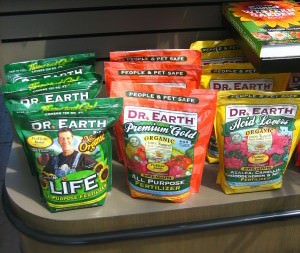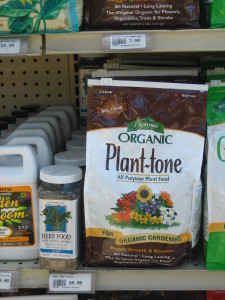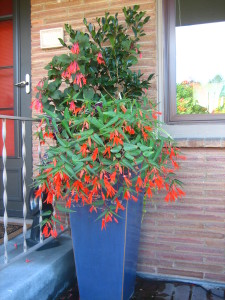Basics of Container Gardening Design: Container Gardens and Fertilizer
Feeding Container Gardens
 It always surprises me how
obsessed gardeners are with chemicals – and I mean all kinds of gardeners, including
organic gardeners.
It always surprises me how
obsessed gardeners are with chemicals – and I mean all kinds of gardeners, including
organic gardeners.
It’s as if folks are seeking some kind of ‘magic bullet’ that will correct every single thing lacking in their garden in just a few applications. This is especially true of fertilizer. Even if it is an organic fertilizer, it still qualifies as a chemical.
Some years ago the magic bullet was spraying plants with seaweed extract; next it was compost tea; then fish fertilizer – whichever organic products were the buzz at the time. Of course, if one is gardening organically, any of the aforementioned products is better than applying a product made from non-organic ingredients, but even these can be overused. As I tell my clients, all the fertilizer in the world won’t make up for a badly designed or maintained planting.
 Container gardens, especially spring and
summer ones, are the teen-aged children of the plant world: They like to eat. They need
fertilizer to look good all summer long.
Container gardens, especially spring and
summer ones, are the teen-aged children of the plant world: They like to eat. They need
fertilizer to look good all summer long.
I was reared up in this industry by very old-fashioned landscapers. I was taught to put slow-release fertilizer and 10-20-20 general purpose fertilizer in the pot before planting and then fertilize with a 20-20-20 water soluble fertilizer once a week during the warm season. I joke and say I don’t know why my containers didn’t explode or just give spontaneous birth to a meth lab. Nowadays, my container design is more organically focused and I use a granular fertilizer with mycorrhizae in it instead, which I mix into the top four or so inches of soil in the planter.
I also add a slow-release fertilizer at planting time, but not after that. Container
plantings may need extra food during the course of the season. There are fertilizers meant
to be dissolved in water and used as a soil and leaf drench. However, excess fertilizer of
any kind eventually winds up in the nearest body of water, so use as little as you need to
get the effect  you are after. In fact, sometimes you
will find that a plant does not like added fertilizer over the course of the season and no
matter how little you use you will see some tip burn. Annuals in outdoor containers usually
do need the extra fertilizer, but not as much as you might think.
Blooming depends as much on how warm the season is as on the application of fertilizer. If
you like the results you are getting without adding a soluble fertilizer, why add anything
more at all? It just adds to the cost of container gardening, both in time and money.
you are after. In fact, sometimes you
will find that a plant does not like added fertilizer over the course of the season and no
matter how little you use you will see some tip burn. Annuals in outdoor containers usually
do need the extra fertilizer, but not as much as you might think.
Blooming depends as much on how warm the season is as on the application of fertilizer. If
you like the results you are getting without adding a soluble fertilizer, why add anything
more at all? It just adds to the cost of container gardening, both in time and money.
That being said, it is usually best to fertilize your container garden early in the day or at any point on a cloudy day. Do not fertilize during the hottest part of the day. Never fertilize when your container plantings are dry – water them well first and then fertilize! Fertilizing a dry container garden leads to plant death.

